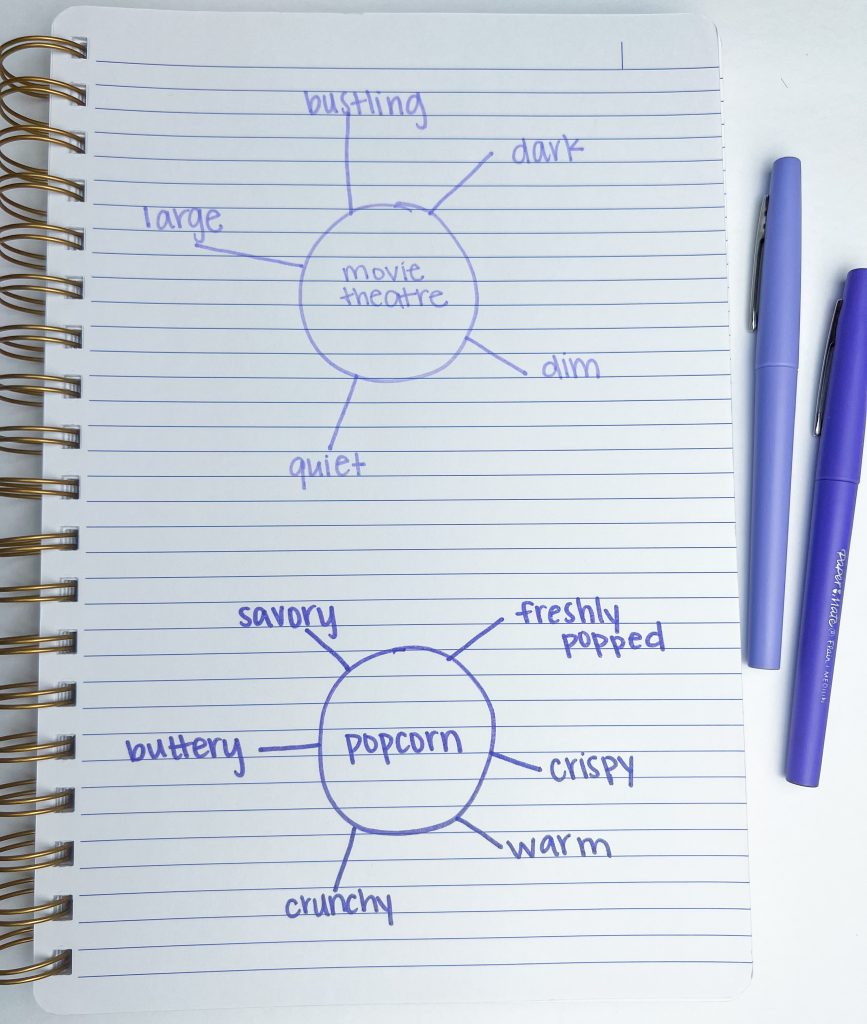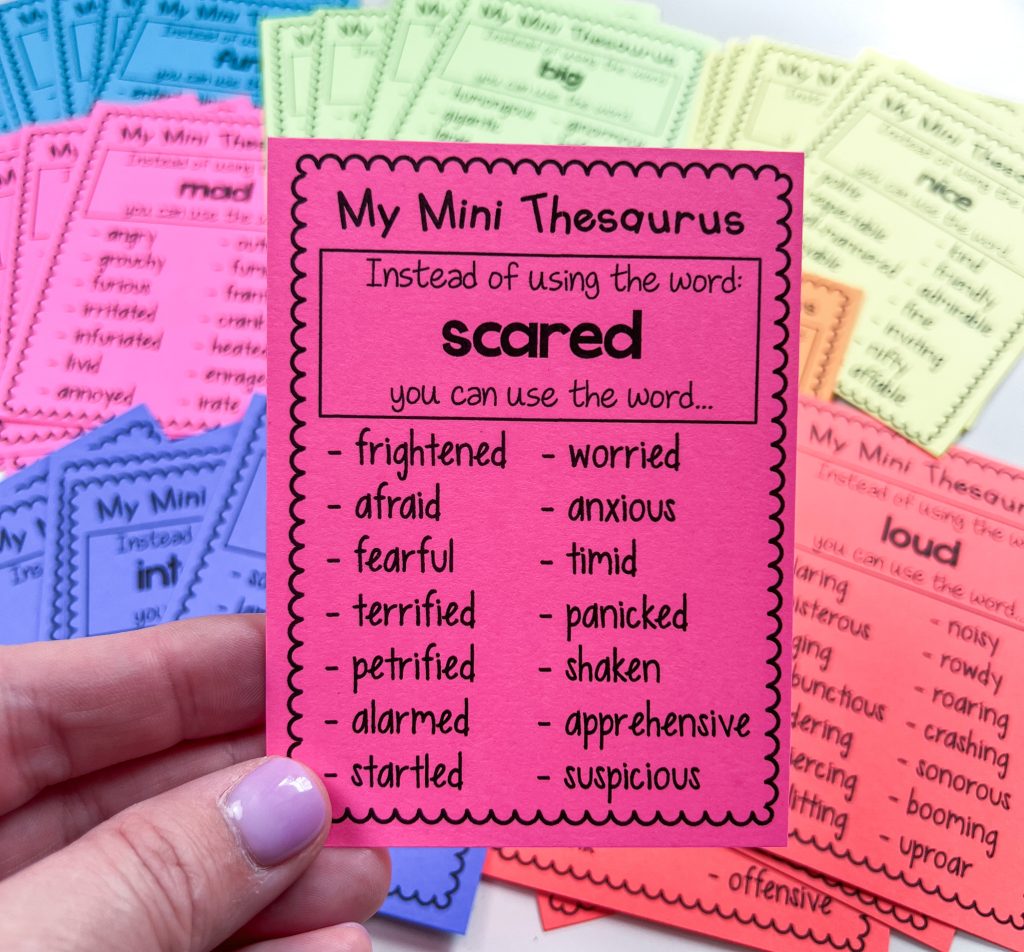
7 Excellent Word Choice Strategies for Teaching Descriptive Writing
How many of you are tired of reading compositions that have the same BORING words in them? Let’s turn those dull, drab words into invigorating, powerful ones. Part of writing descriptively starts right with the words we are choosing! In this post, we are diving into descriptive writing and how to get exciting word choices from our students. If you prefer to hear this information versus reading about it, you can listen to episode 96 of The Literacy Dive Podcast.
The Power of Word Choice
How many of your students use the same words over and over again? Words like good, bad, sad, and happy. These are words that just about push us over the edge. Our students use these same repetitive words because it feels comfortable for them. But that is when I began the practice of implementing ways to get them out of that comfort zone and started helping them think more creatively about the words they are choosing and using.

7 Strategies to Strengthen Word Choice
1. Model Using the Language
Don’t overlook the power of your modeling and sharing. This is such a clear way to set your expectations of what you want them to try. Many students have to see, watch, and listen to your thinking. Use a dull word, and intentionally correct it, out-loud, so that your students see how you make the stronger word choice.
2. More Action, More Passion
Let’s focus on verbs and adverbs. When thinking about the action words, encourage your students to elevate their action words by introducing adverbs. This will help describe that verb and make it a more enjoyable read for the audience.
For example:
“I walked down the street.” This could turn into, “I walked cautiously down the street.”
Adding in the adverb to describe how they walked shows that maybe something fishy is happening and the tone of the sentence tells me that maybe we need to be more aware. Adverbs are a GAME CHANGER with descriptive writing and connecting with the audience.
3. Use More Adjectives
Let’s place focus on the nouns for this one. One of the easiest ways to get students to use better word choice in their writing is to go after the noun. When students simply state something like, “I went to the movie theatre and ate some popcorn.” there are nouns we could advance. Have students generate the adjectives that could be used to describe the movie theatre AND the popcorn. Once they have shared out, you will model turning the sentences into an extremely descriptive one.
4. Draw From Your Five Senses
Here, students will practice improving word choice by using their five senses. First, they will choose a sentence from their writing that they want to improve. Next, they will make a small web or a column chart that is going to give them descriptive words connected to their sentence by way of the five senses. If using the chart form, you can have the five senses at the top, and then words can go underneath each column. If using the web, their word can be in the middle of the web and any words that are connected to the word or sentence can be drawn off from the initial circle.


5. Look For Examples
For this strategy, you will have your students dig into texts and become more aware of the print that is around them. Be intentional in your read-alouds and have them pay close attention to the AMAZING word choices used by authors. Ask your students how it makes them feel as a reader and have them share. We want to point out that we ultimately want our audience to have that same experience and feel all the feels too. Exposure is key here. When more students can pay attention to when powerful words are used and then practice using them, the language will become second nature to them, and their compositions will be drastically enhanced.
6. Partner Practice
Here, you will give simple sentences with commonly overused words. Have your students work in pairs to create 2-3 new sentences that can spice up that plain sentence. Since we know share time is CRITICAL, have the partner groups share with the class. This exposes more opportunities for students to learn from each other and expand their learning. The more sharing, the better, as this will help activate students’ brains and they will start slowly but surely applying everything they are hearing to their writing. Having a partner provides support and joint creativity, and those sentences can be WAY better than what one student could do on their own.
7. Use a Thesaurus.
THEY ARE SCARY, I know! But if you have access to these, allow students to explore them first to see what they look like and what they notice about them. Then, you can start teaching students how to use them. These are invaluable resources that provide several synonyms and substitutes that your students can draw from and use to replace those boring words in their writing. The key with this though, is that students must know how to spell the word to find it. Online thesauruses are a great option too, as they help guide the students with finding the word they are searching for and help with the “spelling” obstacle.
I made a mini thesaurus for my students so that they did not feel as overwhelmed when searching for words. This mini thesaurus is PERFECT for any elementary student or beginning writer and literally changed the game. It has a format for EVERY single child; a booklet format, digital option, mini-anchor charts that can be glued into notebooks or put on a reference ring, and large standard charts that could be hung on classroom walls. There is also a blank chart option for students to select words that they use over and over again and they can start filling in the synonyms that they find. Talk about promoting independence and ownership in their learning.



Some of the ways to get the exemplary word choice that you desire are to use one or several of these strategies in your classroom. By incorporating these into your teaching, you can guide your students to step beyond their comfort zones and feel assured in their word choice and selection. I just know that both you AND your students will witness the transformation of compositions going from boring to captivating in no time.
Share it:
- Read more about: Teacher Tips, Vocabulary, Writing
You might also like...

Hey, I'm Megan!
I am a literacy specialist and curriculum designer who loves sharing tips and ideas to help students thrive in literacy! It brings me joy to await those a-ha moments and to see light bulbs turn on!
I have a huge passion for reading and writing and love to co-mingle the two any chance I get! You can expect to learn new strategies and ways to keep your students engaged during your literacy block! I am so glad you’re here!




